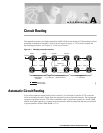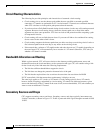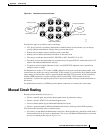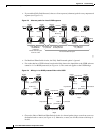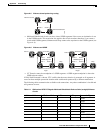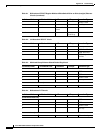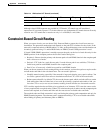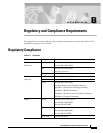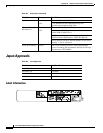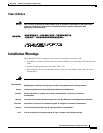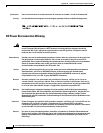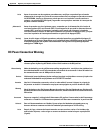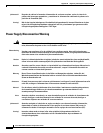
A-7
Cisco ONS 15454 Installation and Operations Guide
November 2001
Appendix A Circuit Routing
Constraint-Based Circuit Routing
Although virtual UPSR segments are possible in VT Tunnels, VT tunnels are still considered
unprotected. If you need to protect VT circuits either use two independent VT tunnels that are diversely
routed or use a VT tunnel that is routed over only 1+1 or BLSR (or a mix) links.
Constraint-Based Circuit Routing
When you create circuits, you can choose Fully Protected Path to protect the circuit from source to
destination. The protection mechanism used depends on the path CTC calculates for the circuit. If the
network is comprised entirely of BLSR and/or 1+1 links, or the path between source and destination can
be entirely protected using 1+1 and/or BLSR links, no PPMN (virtual UPSR) protection is used.
If virtual UPSR (PPMN) protection is needed to protect the path, set the level of node diversity for the
PPMN portions of the complete path on the Circuit Creation dialog box:
• Required—Ensures that the primary and alternate paths of each PPMN domain in the complete path
have a diverse set of nodes.
• Desired—CTC looks for a node diverse path; if a node diverse path is not available, CTC finds a
link diverse path for each PPMN domain in the complete path.
• Don’t Care—Creates only a link diverse path for each PPMN domain
When you choose automatic circuit routing during circuit creation, you have the option to require and/or
exclude nodes and links in the calculated route. You can use this option to:
• Simplify manual routing, especially if the network is large and selecting every span is tedious. You
can select a general route from source to destination and allow CTC to fill in the route details.
• Balance network traffic; by default CTC chooses the shortest path, which can load traffic on certain
links while other links are either free or less used. By selecting a required node and/or a link, you
force the CTC to use (or not use) an element, resulting in more efficent use of network resources.
CTC considers required nodes and links to be an ordered set of elements. CTC treats the source nodes
of every required link as required nodes. When CTC calculates the path, it makes sure the computed path
traverses the required set of nodes and links and does not traverse excluded nodes and links.
The required nodes and links constraint is only used during the primary path computation and only for
PPMN domains/segments. The alternate path is computed normally; CTC uses excluded nodes/links
when finding all primary and alternate paths on PPMNs.
At destination nodes only
1 - - - VT tunnel end point
Table A-4 Bidirectional VT Tunnels (continued)
# of Inbound Links # of Outbound Links # of Sources # of Drops Connection Type





